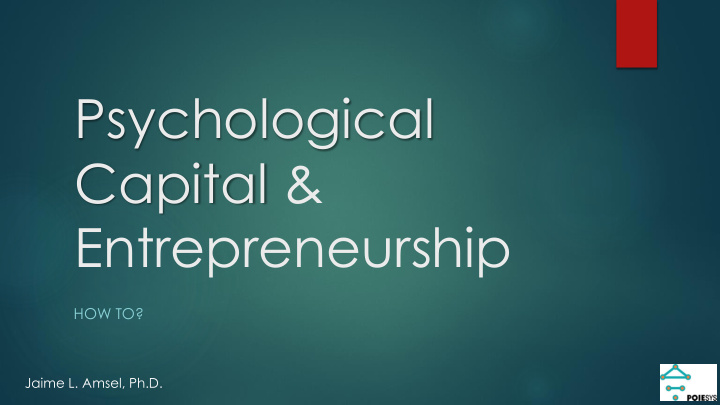



Psychological Capital & Entrepreneurship HOW TO? Jaime L. Amsel, Ph.D.
1 = Strongly disagree, 2 = disagree, 3 = somewhat disagree, 4 = somewhat agree, 5 = agree, 6 = strongly agree
____ 1. I feel confident in representing my work area in meetings with management. ____ 2. I feel confident contributing to discussions about the company's strategy. ____ 3. I feel confident presenting information to a group of colleagues. ____ 4. If I should find myself in a jam (stuck) at work, I could think of many ways to get out of it. ____ 5. Right now I see myself as being pretty successful at work. ____ 6. I can think of many ways to reach my current work goals. ____ 7. At this time, I am meeting the work goals that I have set for myself. ____ 8 . I can be “on my own” so to speak at work, if I have to. ____ 9. I usually take stressful things at work in stride (at pace/progress). ____ 10. I can get through difficult times at work because I've experienced difficulty before. ____ 11. I always look on the bright side of things regarding my job. ____ 12 . I’m optimistic about what will happen to me in the future, as it pertains to work.
2 “Stories”
“The best places to work are no longer those that promise lifetime employment but, rather, those that provide their participants with the opportunities, resources, and flexibility for sustainable growth, learning and development” Luthans et al. 2007
Failure, how do we treat you? I’ve missed more than 9000 shots in my career. I’ve lost almost 300 games. 26 times I’ve been trusted to take the game winning shot and missed. I’ve failed over and over and over again in my life. And that is why I succeed. Michael Jordan
Action cures fear, inaction creates terror . Douglas Horton
History Bandura, A. (1997). Self-Efficacy: the exercise of control . Hunter, J. E. & Schmidt, F. L. (1983). Quantifying the effects of psychological interventions on employee job performance and work-force productivity. Seligman, M. (1998). Learned Optimism . Cameron, K. Dutton, J. & Quinn, R. (2003). Positive Organizational Scholarship. Luthans, F. Youssef, C. M. & Avolio, B. J. (2007). Psychological Capital. Positive Psychology/POB, Resiliency, Employability, Attitudinal
4 components… so far Self Hope Optimism Resiliency Efficacy
Self Efficacy IF YOU THINK YOU CAN OR YOU THINK YOU CANNOT IN BOTH CASES YOU ARE RIGHT!
Self Efficacy 1. Specific 2. Mastery 3. Always can be better 4. Others affect me
Impossible or… I’m possible
Self Efficacy The best predictor of success in any behavior change/acquisition of new capabilities!
Small Incremental Successes Success Analyses Vicarious MASTERY Experiences Initiated Experiences Experiences Failures Self Social Role Efficacy Self and Models and Social Reference Persuasion Groups "Right” Goal set 1... 2... 3... Emotional 4... Physiological 5... States
Often, imposible is what we have not tried yet You miss 100 % of those shots you don’t take Wayne Gretzky
I was lucky, I had to make an effort to get whatever I achieved in life
Hope
HOPE Agency: “I am the cause” Flexpective Flexsistence
1. Goal Setting 2. Goal Stretching 3. Stepping 4. Involvement Why do managers avoid 5. Reward high hopefuls while embrace low hopefuls? 6. Resources 7. Strategic Alliance 8. Training
Hope: dangers Un-realistic hopes The end justifies the means
Optimism
Flexistence תוימיטפוא שוריפ ןונגס (Explanatory Style) םיסחיימ ונא דציכ (Attribution) / םיעוריא : םיילילש וא םייבויח רבע – הווה – דיתע "כ םייבויח םיעוריא לש סוחיי : םיישיא +םיעובק + םיימינפ כ םיילילש םיעוריא לש סוחיי : םיינוציח +םיינמז +בצמ יולת " (M. Seligman) עוריאל םאתהב ימיספ םגו ימיטפוא םג תויהל ןתינ.
Developing your optimism Schneider, 2001 1. Forgive your past 2. Acknowledge / Thankful for your present 3. Opportunity seeking for your future
Resiliency
Resilience The capacity to bounce back from: conflict, failure, difficulty and even positive events: promotion, enhanced responsibility. (Luthans, 2002) Once you get back from this field trip, how your resilience will be tested?
Bonanno
Change how people think PsyCap The path from idea 2 reality Chaos (psych cap, market, luck)/ Idea – need – concept – proof of . Encourage people to enterprise Select / Discourage / work with 3% Intrapreneurs Select / Community of Practice /Challenge Youth at risk to enterprise See above Sell ideas Pitch/ Passion/ Story / Success Formula /Team How convince they are innovative Do not / sell what they do / see above How to chose cofounders Only if absolutely necessary / Trust / Hetereog. Complex idea to look simple 10 yr. old / practice / metaphor How 2 negotiate w/your “father” With respect / PsyCap Increase survival rate of Start ups Increase their number Raise funds / Get a loan Earn their trust / Sell ideas Culture of Innov/Entreprise Change by doing Framework innovation step by step OT2I / InnovAction Bootcamp
Recommend
More recommend